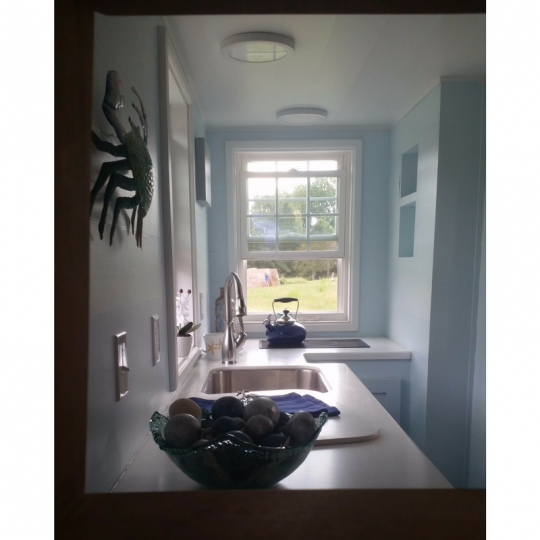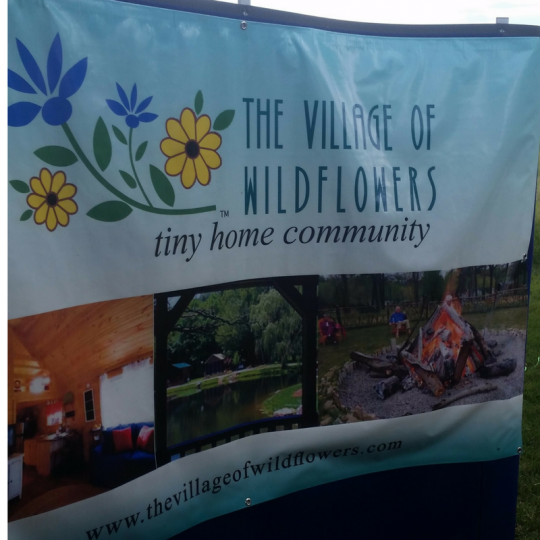This summer, we visited the Daniel Stowe Botanical Gardens, in Charlotte, North Carolina, to see a tiny home exhibit. There we met the folks behind The Village of Wildflowers, a tiny home community that focuses on two things: sustainability and enjoying life.
1.How did The Village of Wildflowers get started?
Gil & Robin Gilman identified a need for affordable housing.
2.How important was creating tiny homes that were comfortable, but also sustainable?
Creating comfortable tiny homes was easy. They include all the same comforts of a normal home: bathrooms, kitchens, dining space, living space with flat screen TV’s, just in a smaller package with more windows, for natural light, bringing inside the connection with the outdoors.

3.On a recent visit to the tiny home exhibit at the Daniel Stowe Botanical Garden, we talked a little about the composting toilet feature in The Village of Wildflowers tiny homes; do they all have this feature? What inspired the company to include this feature in the tiny homes?
Composting toilets, currently there is only one TH (Tiny Home) in the village using a Natures Head composting toilet. Our Shonsie model (our towable demonstrator) also has one. Most people believe a composting toilet emit odors hence most everyone opts for a standard flush toilet.
Composting toilets use the natural processes of decomposition and evaporation to recycle human waste. Waste entering the toilet is over 90% water, which is evaporated and carried back to the atmosphere through the vent system. The small amount of remaining solid material is converted to useful fertilizing soil by natural decomposition.
This natural process, essentially the same as in your garden composter, is enhanced in commercial composting toilets by manipulating the environment in the composting chamber.
The correct balance between oxygen, moisture, heat and organic material is needed to ensure a rich environment for the aerobic bacteria that transform the waste into fertilizing soil. This ensures odor-free operation and complete decomposition of waste.
When human waste is properly composted, the end product does not contain any pathogens or viruses (these are destroyed by bacterial breakdown). The nutrient-rich fertilizer can be used on plants and around the base of trees, as part of the natural cycling of nutrients reducing the need for commercial fertilizers and preserving local water quality. *
4.What other sustainable features are included in rentable and buyable tiny homes through The Village of Wildflowers?
Other sustainable features of the 26 acre Village are no use of fertilizers, herbicides and pesticides, and less housing sprawl (each TH is on a 1/8 acre plot of land). Also, mini splits for heat and air conditioning, electric on demand/tank-less hot water heaters, so electricity bills are $35 to $50 per month.

5.What part of transitioning into tiny home life do you believe is the most difficult?
Detaching yourself from stuff/minimizing your belongings.
6.How are tiny homes contributing to a smaller carbon footprint?
TH are 5 to 10 times smaller than the average American home. This contributes to less building materials, drastically lowering energy usage.
7.Do you believe tiny home life can be for everyone? If not, how come?
No, many Americans are brainwashed into buying stuff. Our economy is based largely on consumption and being a good consumer. That thought process is not a fit in the TH lifestyle.
8.How do you think living in a tiny home can inspire individuals to become more eco-friendly?
Understanding the massive reduction in your carbon foot print from your previous choice of dwelling, you naturally become more conscious of the environment and tend to think in more eco-friendly terms.

*Reference: Letsgogreen .com/composting toilets
See the following information link: Sustainability and lower carbon foot print Tiny House vs Conventional House
 Food
Food Farmers
Farmers Sustainable Living
Sustainable Living Living Planet
Living Planet News
News